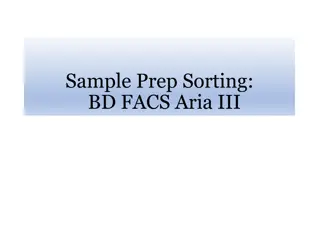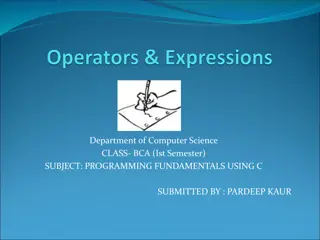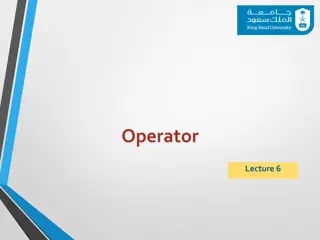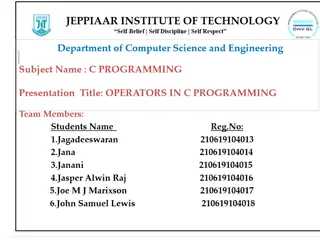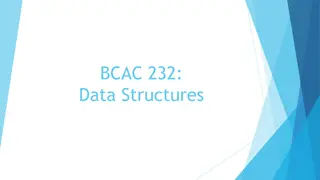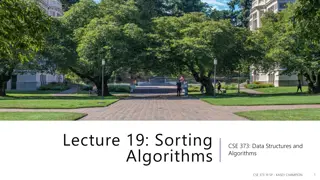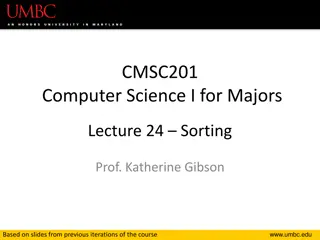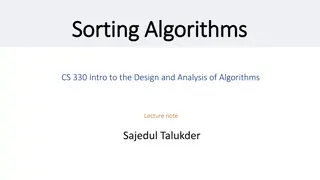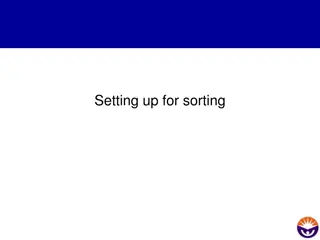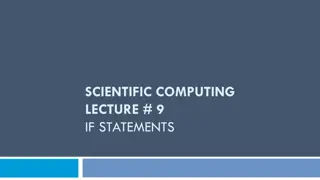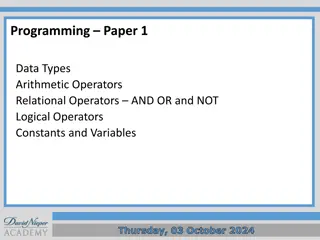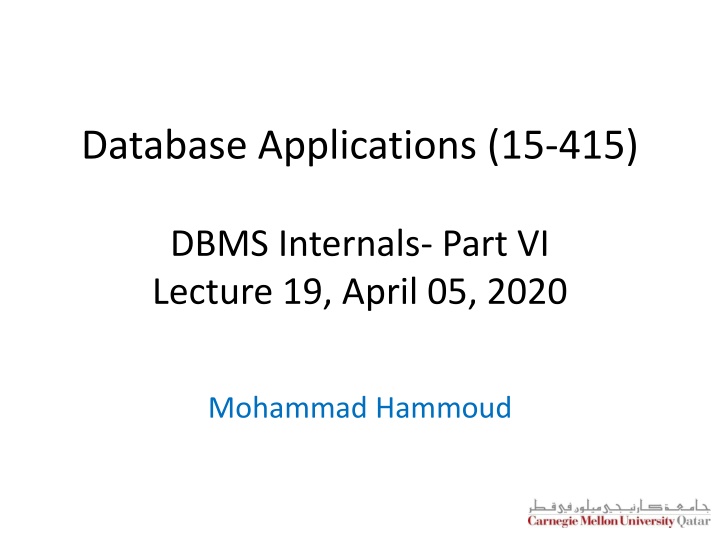
Optimizing Disk Access in DBMS: Blocked I/O and Double Buffering Techniques
Explore the concepts of Blocked I/O and Double Buffering in Database Management Systems to enhance disk access performance through sequential data operations and pre-fetching strategies. Understand the advantages and disadvantages of using bigger buffer units for efficient data processing.
Download Presentation

Please find below an Image/Link to download the presentation.
The content on the website is provided AS IS for your information and personal use only. It may not be sold, licensed, or shared on other websites without obtaining consent from the author. If you encounter any issues during the download, it is possible that the publisher has removed the file from their server.
You are allowed to download the files provided on this website for personal or commercial use, subject to the condition that they are used lawfully. All files are the property of their respective owners.
The content on the website is provided AS IS for your information and personal use only. It may not be sold, licensed, or shared on other websites without obtaining consent from the author.
E N D
Presentation Transcript
Database Applications (15-415) DBMS Internals- Part VI Lecture 19, April 05, 2020 Mohammad Hammoud
Today Last Session: DBMS Internals- Part V External Sorting Today s Session: DBMS Internals- Part VI External Sorting (Cont d) Algorithms for Relational Operations Announcement: P3 is due on Apr 18.
DBMS Layers Queries Query Optimization and Execution Continue with External Sorting Relational Operators Files and Access Methods Transaction Manager Recovery Manager Buffer Management Lock Manager Disk Space Management DB
Outline Linear Hashing Why Sorting? In-Memory vs. External Sorting A Simple 2-Way External Merge Sorting General External Merge Sorting Optimizations: Replacement Sorting, Blocked I/O and Double Buffering
Blocked I/O and Double Buffering So far, we assumed random disk accesses Would cost change if we assume that reads and writes are done sequentially? Yes How can we incorporate this fact into our cost model? Use bigger units (this is referred to as Blocked I/O) Mask I/O delays through pre-fetching (this is referred to as double buffering)
Blocked I/O Normally, we go with B buffers of size (say) 1 page INPUT 1 INPUT 2 . . . . . . . . . OUTPUT INPUT 5 Disk Disk
Blocked I/O Normally, we go with B buffers of size (say) 1 page INSTEAD: let us go with B/b buffers, of size b pages INPUT 1 OUTPUT INPUT 2 . . . . . . Disk Disk 3 Main memory buffers
Blocked I/O Normally, we go with B buffers of size (say) 1 page INSTEAD: let us go with B/b buffers, of size b pages What is the main advantage? Fewer random accesses (as some of the pages will be arranged sequentially!) What is the main disadvantage? Smaller fan-in and accordingly larger number of passes!
Double Buffering Normally, when, say INPUT1 is exhausted We issue a read request and We wait INPUT 1 INPUT 2 . . . . . . . . . OUTPUT INPUT B-1 Disk Disk B Main memory buffers
Double Buffering INSTEAD: pre-fetch INPUT1 into a `shadow block When INPUT1 is exhausted, issue a read BUT, also proceed with INPUT1 Thus, the CPU can never go idle! INPUT 1 INPUT 1' INPUT 2 OUTPUT INPUT 2' OUTPUT' b block size Disk INPUT k Disk INPUT k' B main memory buffers, k-way merge
Using B+ Trees for External Sorting Scenario: the relation to be sorted has a B+ tree index on its primary key IDEA: retrieve records in order by traversing leaf pages Is this a good idea? What if the B+ tree is clustered? What if the B+ tree in un-clustered?
Using Clustered B+ Trees for Sorting Index (Directs search) Data Entries ("Sequence set") Data Records What if Alternative (1) is in use? Cost: root to the left-most leaf, then retrieve all leaf pages What if Alternative (2) or (3) is in use? Cost: root to the left-most leaf, then fetch each page just once
Using Un-clustered B+ Trees for Sorting Index (Directs search) Data Entries ("Sequence set") Data Records Is Alternative (1) an option? No What if Alternative (2) or (3) is in use? Cost: root to the left-most leaf, then fetch pages Worst-case: 1 I/O per each data record!
Using B+ Trees for External Sorting Scenario: the relation to be sorted has a B+ tree index on its primary key IDEA: Can retrieve records in order by traversing leaf pages Is this a good idea? What if the B+ tree is clustered? Good idea! What if the B+ tree in un-clustered? Could be a very bad idea!
Summary External sorting is important; a DBMS may dedicate part of its buffer pool for sorting! External merge-sorting: Pass 0: Produces sorted runs of size B(# buffer pages) Later passes: merge runs # of runs merged at a time depends on Band block size A larger B means a smaller # of passes A larger block size means less I/O cost per page, but potentially a larger # of passes Clustered B+ tree is good for sorting; un-clustered tree is usually bad!
DBMS Layers Queries Query Optimization and Execution Relational Operators Files and Access Methods Transaction Manager Recovery Manager Buffer Management Lock Manager Disk Space Management DB
Outline Introduction The Selection Operation The Projection Operation
Relational Operations We will consider how to implement: Selection ( ) Projection ( ) Join ( ) Set-difference ( ) Union ( ) Aggregation (SUM, MIN, etc.) and GROUP BY Since each operation returns a relation, ops can be composed! After we cover how to implement operations, we will discuss how to optimize queries (formed by composing operators)
Assumptions We assume the following two relations: Sailors (sid: integer, sname: string, rating: integer, age: real) Reserves (sid: integer, bid: integer, day: date, rname: string) For Reserves, we assume: Each tuple is 40 bytes long, 100 tuples per page, 1000 pages For Sailors, we assume: Each tuple is 50 bytes long, 80 tuples per page, 500 pages Our cost metric is the number of I/Os We ignore the computational and output costs
Outline Introduction The Selection Operation The Projection Operation
The Selection Operation Discussions on: Simple Selection Conditions General Selection Conditions
The Selection Operation: Basic Approach Consider the following selection query, Q: SELECT * FROM Reserves R WHERE R.rname = Joe How can we evaluate Q? Scan Reserves entirely Check the condition on each tuple Add the tuple to the result if the condition is satisfied What is the I/O cost? 1000 I/Os (since Reserves contains 1000 pages)! Can we do better?
How to Improve Upon the Basic Approach for Selections? We can utilize the information in the selection condition and use an index (if a suitable index is available) For instance, a B+ tree index on rname can be used to answer Q considerably faster But, an index on bid (for example) would not be useful! Different data organizations dictate different evaluations for the selection operation: No Index, Unsorted Data No Index, Sorted Data B+ Tree Index Hash Index
No Index, Unsorted Data Assume a selection operation of the form: ( ) R . R attr op value If there is no index on R.attr and R is not sorted, we have to scan R entirely Therefore, the most selective access path is a file scan During the file scan, for each tuple, we test the condition R.attropvalueand add the tuple to the result if the condition is satisfied (this is the basic approach!)
No Index, Sorted Data Assume a selection operation of the form: ( ) R . R attr op value What can be done if there is no index on R.attr but R is sorted? Do a binary search to locate the first tuple Start at the located tuple and scan R until the selection condition is no more satisfied Therefore, the most selective access path is a sorted-file scan I/O cost = O(log2M) + scan cost (which can vary from 0 to M)
B+ Tree Index Assume a selection operation of the form: ( ) R . R attr op value What can be done if there is a B+ tree index on R.attr? Search the tree to locate the first index entry that points to a qualifying tuple of R (STEP 1) Scan the leaf pages to retrieve all entries in which the key value satisfies the selection condition (STEP 2) What would be the I/O cost? STEP 1: 2 or 3 I/Os STEP 2: Depends on the number of qualifying tuples, the employed alternative and whether the index is clustered
B+ Tree Index (Contd) What if the index uses Alternative (1)? The leaf pages contain the actual tuples and no additional cost is incurred What if the index is clustered and uses Alternative (2) or (3)? Best case: 1 I/O Worst case: # of leaf pages scanned What if the index is un-clustered and uses Alternative (2) or (3)? Each index entry can point to a qualifying tuple on a different page Cost = 1 I/O per a qualifying tuple! Can we do better?
B+ Tree Index (Contd) Important refinement for un-clustered indexes: Find qualifying index entries Sort the rids by their page-id component Read tuples in order This ensures that each data page is fetched just once I/O Cost = 1 I/O per a data page (vs. 1 I/O per a qualifying tuple)!
Hash Index Assume an equality selection operation S of the form: ( ) R = . R attr value The best way to implement S is to use a hash index (if available on R.attr) Cost = 1 or 2 I/Os (to retrieve the appropriate bucket page) + # of I/Os to retrieve qualifying tuples (could be 1 or many) The cost of retrieving qualifying tuples depends on: The number of such tuples Whether the index is clustered or un-clustered!
The Selection Operation Discussions on: Simple Selection Conditions General Selection Conditions
General Selection Conditions Thus far, we have considered only simple selection conditions of the form R.attr op value In general, a selection condition is an expression with logical connectives (i.e., and ) of terms E.g., R.rname = Joe R.bid=r A selection with conjunctions of conditions is said to be in Conjunctive Normal Form (CNF) and each condition is called a conjunct A conjunct can contain disjunctions and is said to be disjunctive
Two General Cases We will discuss general selections: Without Disjunctions With Disjunctions
Two General Cases We will discuss general selections: Without Disjunctions With Disjunctions
Evaluating Selections without Disjunctions There are mainly three cases to consider: Case 1: No index is available on any of the conjuncts Scan the relation! Example: Consider day<24/3/2015 AND bid=5 AND sid=3 Scan Reserves and retrieve tuples For each retrieved tuple check day<24/3/2015 AND bid=5 AND sid=3
Evaluating Selections without Disjunctions There are mainly three cases to consider: Case 2: There is one index available for one of the conjuncts Use that index to retrieve tuples that satisfy the pertaining conjunct Check for each retrieved tuple any remaining conjunct which does not match the index
The Single-Index Approach: Examples Consider day<24/3/2015 AND bid=5 AND sid=3: Example 1: A B+ tree index on day is available; hence, use that index to retrieve tuples that satisfy day < 24/3/2015 For each retrieved tuple check bid=5 and sid=3 Example 2: A hash index on <bid, sid> is available; hence, use that index to retrieve tuples that satisfy bid=5 and sid= 3 For each retrieved tuple check day< 24/3/2015
Evaluating Selections without Disjunctions There are mainly three cases to consider: Case 3: Multiple indices are available Get sets of rids (assuming Alternative (2) or (3)) using each matching index Intersect these sets of rids Retrieve the tuples Check for each retrieved tuple any remaining conjuncts which do not match indices
The Multiple-Indices Approach: An Example Consider day<24/3/2015 AND bid=5 AND sid=3: If we have a B+ tree index on day (Id) and an index on sid (Is), we can: Retrieve rids satisfying day < 24/3/2015 using Id Retrieve rids satisfying sid=3 using Is Intersect results Retrieve tuples and check bid=5
Two General Cases We will discuss general selections: Without Disjunctions With Disjunctions
Evaluating Selections with Disjunctions There are mainly three cases to consider: CASE 1: If a conjunct, C, is a disjunction of terms and one term requires a file scan, testing C would require a file scan Example: Consider day<8/9/94 OR rname= Omar and assume hash indices on rname (i.e., I1) and sid (i.e., I2) are available We can retrieve tuples satisfying rname = Omar using I1 However, day<8/9/94 requires a file scan Hence, as the file scan is to be done, we can check the condition rname= Omar and preclude using I1 Therefore, the most selective access path is a file scan only
Evaluating Selections with Disjunctions There are mainly three cases to consider: CASE 2: If the selection condition is CNF and contains a conjunct with a disjunction, we can take advantage of other conjuncts Example: Consider (day<1/1/99 OR rname= Joe ) AND sid=3. Suppose also the existence of a hash index on sid (Is) We can use Is to find qualifying tuples on sid and check for each retrieved tuple day<1/1/99 OR rname= Joe Therefore, the most selective access path is the index on sid
Evaluating Selections with Disjunctions There are mainly three cases to consider: CASE 3: If every term in a disjunction has a matching index, we can retrieve candidate tuples using the indices and union them all Example: Consider day<8/9/94 OR rname= Alice and suppose B+ indices on day (i.e., I1) and rname (i.e., I2) are available We can retrieve tuples satisfying day<8/9/94 using I1 In addition, we can retrieve tuples satisfying rname = Alice using I2 We can subsequently union their results Q: What if all matching indices use Alternative (2) or (3)? A: Apply the refinement for un-clustered indices!
Outline Introduction The Selection Operation The Projection Operation
The Projection Operation Consider the following query, Q, which implies a projection: SELECTDISTINCT R.sid, R.bid FROM Reserves R How can we evaluate Q? Scan R and remove unwanted attributes (STEP 1) Eliminate any duplicate tuples (STEP 2) STEP2 is difficult and can be pursued using two basic approaches: Projection Based on Sorting Projection Based on Hashing
The Projection Operation Discussions on: Projection Based on Sorting Projection Based on Hashing
Projection Based on Sorting The approach based on sorting has the following steps: Step 1: Scan R and produce a set of tuples, S, which contains only the wanted attributes Step 2: Sort S using external sorting Step 3: Scan the sorted result, compare adjacent tuples, and discard duplicates What is the I/O cost (assuming we use temporary relations)? Step 1: M + T I/Os, where M is the number of pages of R and T is the number of pages of the temporary relation Step 2: 2T # of passes I/Os Step 3: T I/Os
The Projection Operation: An Example Consider Q again: SELECTDISTINCT R.sid, R.bid FROM Reserves R How many I/Os would evaluating Q incur? Step 1: M + T = 1000 I/Os + 250 I/Os, assuming each tuple written in the temporary relation is 10 bytes long Step 2: if B (say) is 20, we can sort the temporary relation in 2 passes at a cost of 2 250 2 = 1000 I/Os Step 3: add another 250 I/Os for the scan Total = 2500 I/Os Can we do better?
Projection Based on Modified External Sorting Projection based on sorting can be simply done by modifying the external sorting algorithm How can this be achieved? Pass 0: Project out unwanted attributes Passes 1, 2, 3, etc.: Eliminate duplicates during merging What is the I/O cost? Pass 0: M + T I/Os Passes 1, 2, 3, etc.: Cost of merging
Projection Based on Modified External Sorting: An Example Consider Q again: SELECT DISTINCT R.sid, R.bid FROM Reserves R How many I/Os would evaluating Q incur? Pass 0: M + T = 1000 + 250 I/Os Pass 1: read the runs (total of 250 pages) and merge them Grand Total = 1500 I/Os (as opposed to 2500 I/Os using the unmodified version!)
The Projection Operation Discussions on: Projection Based on Sorting Projection Based on Hashing

